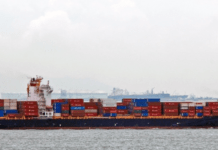
Cancelled capacity has so far matched the decline of global demand give or take 10% according to the Danish consultancy Sea-Intelligence the level of void sailings has now reached three times the capacity reductions for Chinese New Year.
That could change in the third quarter as lines maintain cuts to services amid rising demand. Some 4 million TEU of cancelled capacity globally has been matched by a global demand that has plummeted by 4.4 million TEU this year to date. The major east/west trades have seen the bulk of the cancellations and the fall off in demand, with the latest round of cancellations including a substantial cuts in capacity.
For the customers of the lines the cuts in capacity have gone too far with some suggesting that cargo rollovers have seen a sharp increase in rolled over cargo as shippers fight to get their freight onto the ships.
Forwarder and consultant Jon Monroe claimed that “The carriers have not changed, much,” arguing that the lines are “up their old tricks again.”
According to Monroe the carriers are “Managing space so tightly that even with total volumes down between Asia and the US there is a two-week backlog in Southern China,” on the Pacific trades.
“Did you really think the carriers want partners?” Asked Monroe, adding that the “higher rates will help the carrier buy black ink for their balance sheets.”
Freightos CMO Eytan Buchman, said that “China-US West Coast ocean rates climbed 17% this week due to tight capacity and an unexpected bump in demand. Rates are at their highest level for over one year, dating back to January 2019.”
It is tempting to see the carriers’ strategy as pushing their own agenda, rather than that of the populations at large, with the expectations of rising demand in both the US and Europe and freight already outpacing capacity the next couple of months could be expensive.
“BCO (beneficial cargo owners)’s are issuing new orders in anticipation of the states and store openings. Everyone by now should be feeling it. Everyone I have talked to have provided positive responses to new bookings throughout Asia. The question that we need to answer is how much and for how long. Without consumers frequenting malls and stores this may not be sustainable,” argued Monroe.
While container trade statistics for April 2020 shows demand decline 16.9% year-on-year in April 2020. “In absolute terms, this means a global demand loss of 2.4 million TEU in April 2020, May is expected to be even worse, but the third quarter, traditionally the most active for the lines, the demand equation remains uncertain.
Monroe predicts that, “There is no doubt that the Covid-19 pandemic has changed the way people work, live and shop for the foreseeable future. Many of these changes will be permanent. The retail sector will continue to shift toward online purchases and the retailers equipped to make this transition will not simply survive, they will emerge as the winners. Stores will also become fulfillment centers.”
Buchman believes, “The unexpected spike in demand over the last few weeks combined with tight capacity to push ocean rates up again this week. China-US West Coast rates climbed 17% to $2155/FEU, its highest level since January 2019.”
However, Freightos expect September volumes to be substantially down even with the increased demand, and for Buchman the proof is the cuts in capacity that are continuing through the summer period.
“So far 10-15% of sailings from Asia to Europe have been cancelled through August, and 5-10% have been blanked to the US. The bump in demand has also resulted in some rolled shipments out of China, with some shippers reporting delays of up to two weeks to get on overbooked ships.”
On a broader scale the economic mood music seems to favour the pessimists with the reported flight of investment, the UK economy cited to see a 20% decline in GDP and even with the US returning to work, supposedly, though the reports are that 2 million people filed unemployment claims, while the DOW lost 1,800 points 7% while the S&P lost 6% and the technology market, the Nasdaq lost 5%. he US economy is expected to shrink 6.5% this year and the Organization for Economic Co-operation and Development expects the “worst peace time slump in 100 years”.
Even if the stock markets did see a bounce the prognosis for the global economy for this year remains weak, with one maritime analyst admitting this week that the industry has already written off this year.
Nick Savvides
Managing Editor








